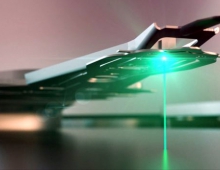
TDK Showcases HAMR Hard Disk With Record Areal Density
TDK will be showcasing a Thermally (Heat) Assisted Magnetic
Recording technology (HAMR or TAMR) at CEARC 2012, which
significantly enhances HDD recording density.
TDK's technology allows for storing data on a hard disk at an areal
density of 1.5 Tbits/(inch)2 and a bit error rate (BER) of just
10-2. Previouly, the compant had acheved a BER of 10-2 with an
areal density of 1 Tbit/(inch)2.
An areal density of 1.5 Tbits/(inch)2 means that 2.5-inch hard disks will be able to store 1TB per platter, while the 3.5-inch vesions will hold 2TB per platter.
The new technology makes it easier to write data by adding heat to the disk platter using a laser. TDK has included the laser diode into the the magnetic head of the HDD.
The so-called heat-assisted magnetic recording (HAMR) uses a magnetic recording medium having high coercivity. When recording data, a magnetic field and heat are simultaneously applied to the area of the magnetic recording medium where to record data, so that the area rises in temperature and drops in coercivity for data recording. In heat-assisted magnetic recording, near-field light is used as a means for applying heat to the magnetic recording medium.
Compared to the company's previous HAMR technology showcase last year, TDK said it had further improved the magnetic head and hard disk medium, provided by Japanese Showa Denko K.K., without providing more details.
TDK expects hard disk drives with enlarged recording capacities to be available in 2014.
An areal density of 1.5 Tbits/(inch)2 means that 2.5-inch hard disks will be able to store 1TB per platter, while the 3.5-inch vesions will hold 2TB per platter.
The new technology makes it easier to write data by adding heat to the disk platter using a laser. TDK has included the laser diode into the the magnetic head of the HDD.
The so-called heat-assisted magnetic recording (HAMR) uses a magnetic recording medium having high coercivity. When recording data, a magnetic field and heat are simultaneously applied to the area of the magnetic recording medium where to record data, so that the area rises in temperature and drops in coercivity for data recording. In heat-assisted magnetic recording, near-field light is used as a means for applying heat to the magnetic recording medium.
Compared to the company's previous HAMR technology showcase last year, TDK said it had further improved the magnetic head and hard disk medium, provided by Japanese Showa Denko K.K., without providing more details.
TDK expects hard disk drives with enlarged recording capacities to be available in 2014.





















